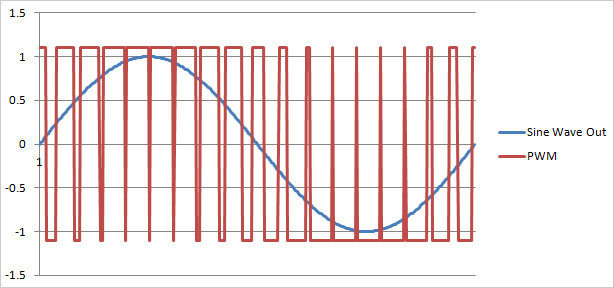Why do we need amplifiers in the first place?
Have you ever tried to plug your phone into a set of passive speakers (please don’t try this)? It won’t work. Passive speakers are notoriously inefficient and your phone doesn’t have enough drive to play them. Your ear buds that came with your phone don’t have to generate much sound pressure (“loudness”) because when you listen to them they are right next to your eardrums. The loud speaker, however, must produce enough sound pressure to fill a whole room! Therefore we need the assistance of an amplifier to faithfully reproduce the input signal at an increased power level to make the powered speakers work properly.
What does the name “Class D” mean?
Class D is just a name given to a certain type of amplifier design. There are a number of different amplifier configurations that are used today. The most popular are Class A, Class B, Class AB and Class D (really unique names aren’t they?). The Class D amplifier design is the newest of these four designs and was first developed in about 1958. It wasn’t a very popular design until the last 10 years as new integrated circuits were developed that made the Class D amplifier less costly with improved performance.
How does the Class D amplifier design differ from the others?
One of the big differences between the Class A, B, or AB amplifier and the Class D amplifier is the efficiency with which the amplifier drives the load (i.e. the speakers). Efficiency is expressed as a percentage and is defined as the power delivered to the load divided by the input power to the amplifier…
Efficiency = (Pload/Pin) X 100
The Class A, B, or AB amplifiers all have at least one final drive transistor operating in the ACTIVE mode all the time. When a transistor is in the ACTIVE mode the transistor conducts current AND the voltage drop across the transistor is relatively significant. The power dissipated by the transistor is determined by the formula…
Power = Voltage X Current
The result of this is unwanted heat generated inside the transistor itself.
Conversely, the Class D amplifier is a switching amplifier. Its final drive transistors always operate in either the OFF or the ON mode. In the OFF mode the transistor will not conduct current, therefore the Voltage X Current product is zero. In the ON mode the transistor will conduct current but the ON voltage across the transistor is very low. Therefore the Voltage X Current product is very low. As a result the Class D amplifier is very much more efficient than the other amplifier models and very little heat is generated in the drive transistors.
So how much more efficient are Class D amplifiers?
The theoretical maximum efficiency of a Class A amplifier is only 25%, Class B is 78.6%, and Class AB is 50%. However a Class D amplifier can achieve efficiency factors of up to 90% and better. In all class types the efficiency factors drop when the amplifier is playing at less than full volume, however given the same output level, the Class D amplifier is always more efficient. As an example, if the amplifier’s power output is reduced to 10% of its maximum power capability, a Class D amplifier’s efficiency will drop to about 78%, but a Class B amplifier will drop to 28% and a Class A amplifier will drop to 3%. At 3% efficiency, 97% of the power consumed is being generated as unwanted heat!
How can a Class D amplifier reproduce all the various voltages it takes to make music if its outputs are always either ON or OFF?
A good analogy that might help is if you think of a light switch. You can turn the light on and you get a bright light or you can turn it off and you have no light. But if you turn it on then off repeatedly very fast in such a way that it is on half the time and off half the time you would experience about 50% of the intensity as if it were turned on 100% (not taking into account the time it takes the light bulb filament to produce light). If you could switch the light on and off such that the light is on 10% of the time and off 90% of the time, the resultant intensity would be about 10% as bright as when it is 100% on. This is basically how a light dimmer works.
In much the same way a Class D amplifier can change the output voltage of the amplifier according to the input voltage by switching its output transistors on and off quickly for various lengths of time. The light intensity in the example above translates into amplifier voltage output. Figure 1 below shows how the on time is varied with respect to the voltage desired. This is what is called Pulse Width Modulation (PWM). Notice how the PWM signal is in the ON (or high) state longer as the sine wave is at its most positive point. Conversely the PWM signal is in the OFF (or low) state longer as the sine wave is at its most negative point.

With all of this switching doesn’t the Class D amplifier generate a bunch of noise?
Yes it does! The fact is that while there is switching noise generated by the Class D amplifier, it is filtered off before the signal is sent to the speaker drivers. Also the switching frequency is above 380 KHz which is well above the 20 KHz maximum that we can hear.
So that’s it? Vanatoo used a Class D amplifier just because it’s more efficient?
There’s more to it than just efficiency. With less power wasted in generating heat, we can use smaller driver transistors and smaller heat sinks. Less power wasted means the power supply does not need to produce power just to generate unwanted heat, so the power supply can be smaller. Sum all of these together and you get a high quality, physically smaller amplifier/power supply system which results in lower overall cost to the customer. The small size, low cost, and high quality are all consistent with Vanatoo’s design goals for the Transparent Series speakers.
Are there any other benefits to the Class D amplifier?
Absolutely, since most of your music is already in digital format (e.g. CDs and downloaded music), if you connect your music source to a digital input on our amplifier (Coax, Optical or USB) your music will remain in the digital domain from your music source, through our digital signal processor (DSP), and on through the Class D amplifier final drivers after which it is converted to analog for the speaker drivers. The result is an audio path that has a minimum of conversions between the analog and digital domains, which is a good thing as each conversion can introduce unwanted distortion. Also the Class D amplifier is very immune to many of the sources of noise and distortion that can be found in other types of amplifiers. That’s not to say that a Class D amplifier is totally immune from distortion and noise. As with any design there are tradeoffs and with Class D amplifiers we need to be careful about other types of noise and distortion that can creep into the system. However, we believe that the Class D amplifier advantages far outweigh the disadvantages and have chosen to use the Class D amplifier in the Transparent Series speaker designs.
Isn’t Vanatoo all about sound quality?
Yes, we are! The recent improvement in the sound quality of Class D amplifiers was one of the key technologies that enabled the design of the Transparent Series systems. But as with other types of amplifiers, not all Class D amplifiers are created equal. The Transparent Series amplifiers are based on an amplifier “chipset” from D2Audio, which was chosen after a lot of careful listening. There are other amplifiers with equally impressive specifications that cost less, but to our ears the D2Audio sounds better. And that’s what we’re all about!
Test Out Vanatoo Speakers Yourself - Try our 30 Day Audition!
